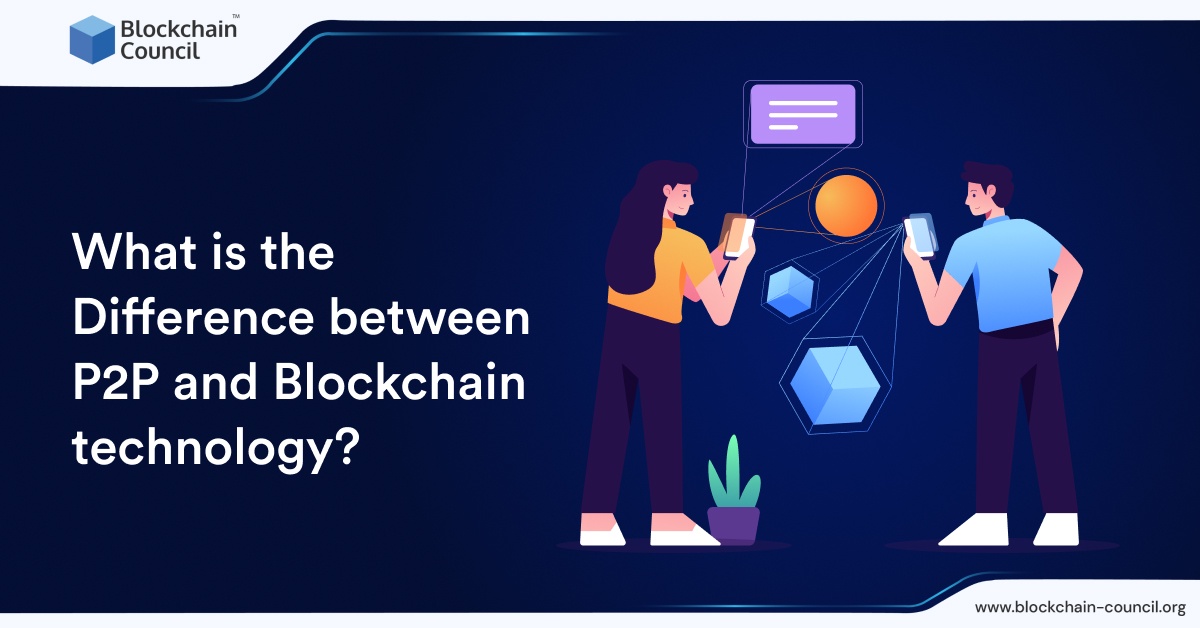You've probably heard that the blockchain technology is a great example of information sharing between peers. But did you know that the two technologies have some distinctions? Blockchain P2P networks serve as a clear illustration of the principles behind the technology. However, there are numerous additional instances where the P2P network is used generally. Since the 1990s, participants have had access to a connected, private, and secure network thanks to the development of blockchain technology.
P2P technology operates under the straightforward tenet that data is collectively stored and shared among network members. An authorization from a central party is not necessary. Each participant checks the information and adds it to the network. The data is shared among the users of blockchain networks, but it is stored in the blocks that are added to the blockchain through mining, so these networks use P2P technology. Since it only makes up a small portion of the overall technology, the P2P network in blockchain has some unique characteristics.
We're here to talk about how the two technologies are different from one another. If you are completely familiar with what a P2P network in a blockchain is and what these technologies stand for on their own, you can better understand these differences. So let's start by getting a handle on both technologies' fundamentals.
What is a peer-to-peer (P2P) network?
The pinnacle of decentralised systems worldwide has been peer-to-peer technology. It is a technique for sharing and storing data in a network of peers that are linked together. The P2P network's primary architecture is appropriate for numerous applications that share data. The use of peer-to-peer networks in blockchain technology is one of the most prominent examples. A network that can be open or private is coded by blockchain developers. The blockchain's distributed P2P network supports a distributed ledger system that links the participants. A peer-to-peer network allows for the sharing of data in a variety of formats. Each participant receives the information that has been shared with them, as well as updates on all network activity.
P2P networks can be categorised as structured, unstructured, or hybrid. Unstructured P2P networks are comparable to open networks, such as the P2P network for bitcoin. Compared to the structured model, it is less efficient because the participants are randomly joined and data flows through every participant node. An efficient network is created when participants are added to a structured model based on some eligibility. Each participant plays a part, and the data verification process is quicker. Private blockchain networks are created by such P2P networks in blockchain.
Last but not least, the hybrid model is regarded as the most practical for all applications. The participant nodes and a variety of client-server based services add the data. The network's overall performance has a tendency to increase thanks to this model.
Blockchain technology and P2P networks have different characteristics
We now have a basic understanding of how blockchain technology utilises the P2P network and how it is not the entire thing. To get a better understanding of the two, let's also consider how these technologies differ from one another.
The first distinction between the two technologies is that blockchain only includes a distributed P2P network as a small portion of the overall technology. Blockchain also includes components like cryptography, consensus mechanisms, and many more in addition to the distributed and decentralised P2P network. This suggests that blockchain does not represent the entire peer to peer network and is actually just one application of it.
Prior to the use of blockchain technology, peer-to-peer technology already existed. It represents the decentralisation of data and the ability of all users to access, edit, and add data to the network. Actually, the blockchain's peer-to-peer network was first used on a large scale with the Bitcoin protocol. As a result, it can be regarded as one of the P2P network's blockchain applications that has achieved the greatest success.
Each computer serves as both the client and the server in a peer-to-peer network. The network's participants are free to communicate with one another and exchange resources. Blockchain networks, on the other hand, are just a way to store and share data openly. The name comes from the format in which the data is stored—a series of blocks.
In this way, the fundamental and most significant distinction between blockchain technology and peer-to-peer networks is found in the latter's primary functions. The peer-to-peer network allows for shared access to all resources and data. Blockchain networks, on the other hand, only allow participants to store and share data.
Other P2P Network Applications
Now that you know, the P2P network in blockchain is merely a particular application of the overall network. There are additional applications of the same that are similar. Through these applications, you can comprehend how the P2P network and blockchain differ from one another. Therefore, let's explore some additional peer-to-peer network applications.
1. File sharing: File sharing is the most fundamental function of a P2P network. It consists of a networked connection of computers that can exchange files with one another. You could think of it as an internal server-based connection. All of the participating computers can access files that are stored on one computer.
2. IP Technology: Peer-to-peer networks are well exemplified by services like Skype's video calling capability. Through a single network, these services distribute connections between numerous users.
3. Shared gaming services: Shared gaming services are one type of content service that falls under the umbrella of peer-to-peer networking. Through a single network, you can access all of the games that are kept on each participant's computer. Even a sophisticated game can be played on your laptop while still running on a PC somewhere else. Through the peer-to-peer network connection, you only get the game's shared screen and the handheld connection.
Conclusion
The fundamental distinctions between the P2P network and blockchain technology have now been covered. Prior to the invention of blockchain, the P2P network already existed. Through a single decentralised network of users, it is a technique for sharing, accessing, and editing files. There are numerous additional uses for peer-to-peer networks that you can learn about through different degree programmes. Numerous courses on blockchain technology, peer-to-peer networks, and other topics are offered by the Blockchain Council. They are a group of tech enthusiasts who spread knowledge about such technologies to the world. Simple courses are a good way to learn about these subjects. Additionally, it is crucial that you continue to expand your knowledge if you want to advance your career in this field.


No comments yet